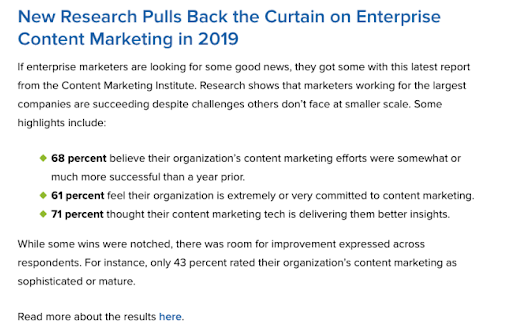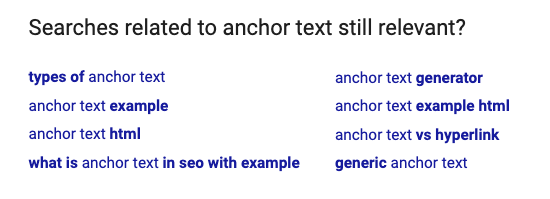What is anchor text?
It’s the clickable text found in a hyperlink.
In this article, I’ll help you gain an understanding of what anchor text is, why it matters, and how to optimize those links for a positive impact on SEO.
What You’ll Learn:
- What anchor text is
- If it matters for SEO
- The difference between internal and external anchor text
- The different kinds of anchor text
- Best practices
- Potential problems
If you spend any time online, you know anchor text. The clickable hyperlinks, characterized by blue, underlined font have become so familiar, it’s easy to forget that they serve a practical purpose.
While some reports, like this one from SparkToro, suggest that the ranking power of anchor text is diminishing, its use in your blog posts and web copy, as well as your external backlinks, still play a role in SERP visibility.
What is Anchor Text?
Anchor text is a term used to describe clickable text found in web content like blog posts, SEO pages, and more. Instead of including entire URLs in your content, anchor text sums up what you can expect upon clicking through.
When done right, it’s designed to provide search engines and readers with more context and plays a key role in internal linking strategies and SEO.
Getting your anchor text right is critical for guiding visitors through your website, and as such, you’ll want to properly optimize your anchors to increase your chances of earning a click-through.
Does It Matter for SEO?
The short answer: yes. But, it is evolving.
Historically, Google has relied on external anchor text as a ranking signal, as described in an early paper explaining how the algorithm works.
While there are many more factors that contribute to the search experience today, anchor text still serves the same purpose as it always has: it’s a contextual signal.
For example, if I write an article using the anchor, “kitchen towels,” Google would take that as a signal that the linked page has something to do with “kitchen towels.”
If other websites also link to that page using the keyword, “kitchen towels,” it signals to Google that this page is a good source of information on that topic, and as such, will likely result in a boost to search rankings.
The idea is that if multiple unrelated pages link to a website using the same or similar anchor text, chances are there’s a high match between the anchor and the content on the page.
Search engines look for variations in the anchor text used to link to a specific article for further information regarding what the content is about.
Additionally, variations can help search engines serve up results that better match searcher intent. Combined with recent relevancy updates like BERT, plus factors like link source and information hierarchy, Google is getting closer to understanding the nuances of user intent.
Internal vs. External Anchor Text
In the old days, external anchor text played a larger role in helping search engines determine relevance. It helped search engines get a sense of how others perceived your page and painted a picture of what your pages were about.
Today, Google still uses external anchor text (aka backlinks from other sites) as a reputational signal, giving you a boost when a high-authority domain links back to your site.
Internally, it plays a key role in helping users navigate through your site.
Internal links establish the relationship between content like SEO and product pages, blog posts, and more. They also define your site’s information hierarchy and spread link value from high-ranking pages throughout your website.
We won’t dig into it much here, but internal link building success relies heavily on the wording used in your anchor text. You’ll want to consider why you’re linking to each page and how to convey its value to your readers.
What are the Different Types of Anchor Text?
Now, let’s go over the different types of anchor text you might use to incorporate in your internal linking strategy or boost your backlinking efforts.
Generic
Generic anchor text refers to links with general phrases like “click here” or “read more” that don’t reveal much about what readers can expect to find if they click.
On its own, generic anchor text isn’t a very effective way to drive clicks. For instance, a standalone “click here” offers nothing for the reader.
Still, generic anchor text can work well in some cases. For example, the newsletter below focuses on a single topic, links to the article at the top of the page, and then uses a generic version as a final CTA.

An example of generic anchor text. Source
Exact Match
Exact match anchor text contains the same target keywords as the page it links to. For example, using ‘SEO best practices’ to link to a page about SEO best practices.
Generally speaking, you’ll want to keep exact match at a bare minimum, as it comes across as spammy when used more than once per page.
Partial Match
Partial match anchor text includes a variation on the keyword targeted by the page it links to. In keeping with the same example, you might use “SEO tips and tricks” to link to the “SEO best practices” page.
Partial match allows you to use your target keyword more frequently in your anchor text in a way that comes across as more “natural” than using exact match.
LSI
Latent Semantic Indexing is a system designed to pull up variations or synonyms when users type in the main keyword.
So, if you’re targeting “2020 blogging tactics,” the LSI results may include “content marketing in 2020,” “how to blog in 2020,” “content strategies for 2020,” etc.
A good example of this is the “searches related to…” found at the bottom of the Google search results. Here’s what comes up if I enter “is anchor text still relevant?” into the search bar:

An example of LSI anchor text
Branded
Branded anchor text is just what it sounds like, with the brand name used as the anchor text. For instance, someone might use “Ignite Visibility” to link to this website.
a branded variation works well for bringing qualified traffic to your landing pages from a blog post on your site or off-page, external sources like guest posts.
As a link-building strategy, collecting branded backlinks from reputable websites can help raise your profile as a thought leader and increase visibility in the SERPs.
When linking to other websites, branded text works best when the brand (or person) is considered an expert on the topic discussed in your content. This might include individual thought leaders, reputable media outlets, or respected industry publications.
Page Title
According to a 2017 Search Engine Journal post, author Adam White swears that the most effective type of anchor text is: Page Title/Blog Post Title.
Here’s how that might look using a recent example from the Ignite blog:
SEO in 2020: A Beginner’s Guide to Writing Content that Ranks
Naked Links
Naked links skip the anchor text and leave the URL exposed, like this: ‘www.ignitevisbility.com.’
Image Anchor Text
Image anchor text is far less common than text-based. This type of anchor is used by Google and uses an image’s alt attribute as anchor text, allowing you to link to another site using a clickable image.
Google’s John Mueller doesn’t recommend using this, stating that it doesn’t help Google understand the context of the website.
Best Practices
While website owners don’t have full control over how other sites link to their page, you can work to ensure that you use descriptive, relevant anchor text to link to other sites and other pages within your own site.
Writing great anchors is relatively straightforward. Your goal here is to use natural language that communicates the value of what’s on the other side of that click.
Here are some dos and don’ts to help guide the process:
Do:
- Be short and specific. Consider the content and intent associated with the page you’re linking to. Try to describe that page using 2-3 words.
- Keep things relevant. It should always accurately represent the page it links to. Search engines compare anchor content with what’s on the external page to determine the relationship between page 1 and page 2. High-relevance signals can improve search performance for both sites, so it’s worth following best practices, even when linking elsewhere.
- Embrace a ‘less is more’ approach to keywords. Again, keep your keywords to a minimum. It doesn’t matter if we’re talking internal or external ones from other sites — overly optimized anchor text portfolios can trigger Google alarm bells for unnaturally acquired links.
- Variation is king. Avoid repeating the same keyword in multiple links. Instead, use similar variations of your target terms for a more natural approach.
Don’t:
- Spam readers. The sites you link to are more important than you might think. On a reputational level, bad links are a sign of poor judgment. More seriously, spammy links can put your website—and your readers—at risk.
- Go Crazy with the Keywords. When a page contains too many keywords linking out to other pages or worse, linking to the same page multiple times using different anchor text, Google could penalize your site. The purpose of anchor text is to provide users with valuable information. It shouldn’t undermine the user-experience on the page.
- Trick users into clicking. As is the case with any form of clickbait, attempting to fool users in an effort to drive traffic is a deceptive practice that undermines the user experience.
- Shoehorn target search terms. Keyword stuffing rules apply to anchor text, too. This means you’ll want to make sure that text sounds natural when read out loud.
- Use your links as an opportunity to express yourself. In other words, you want to make sure your links look like links, so that users can identify the clickable text on the site. Make sure to use a contrasting color and underline the link—when in doubt, stick to convention and use the blue links.
Potential Problems with Keyword Anchor Text
Keyword anchor text is something of a double-edged sword. While keyword terms can offer some serious SEO benefits, they can also land you in hot water.
Overusing search terms could trigger a Google penalty if the text seems unnatural in any way. I recommend reading up on Google’s link schemes guidelines to learn more about which tactics the search engine considers “manipulative.”
Here are a few tips for creating natural-sounding anchor text:
- Create a varied strategy. Use LSI and partial match anchor text and avoid exact match.
- Focus on targeting high-volume search terms. Multiple instances of low-volume keywords might signal that something is up.
- Limit keyword use to a small percentage of your overall anchor text profile. To get a sense of how your anchor text profile should break down, use tools like SEMRush, Ahrefs, or Moz to look at your competitors’ link profiles.
Wrapping Up
Anchor text is designed to provide search engines and readers with more context and plays a key role in internal linking strategies, domain authority, user experience, and SEO.
While it might not be the most important part of your 2020 SEO strategy, anchor text remains an important tool for helping users find more valuable information.
